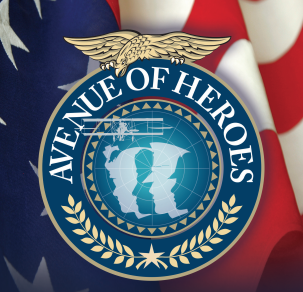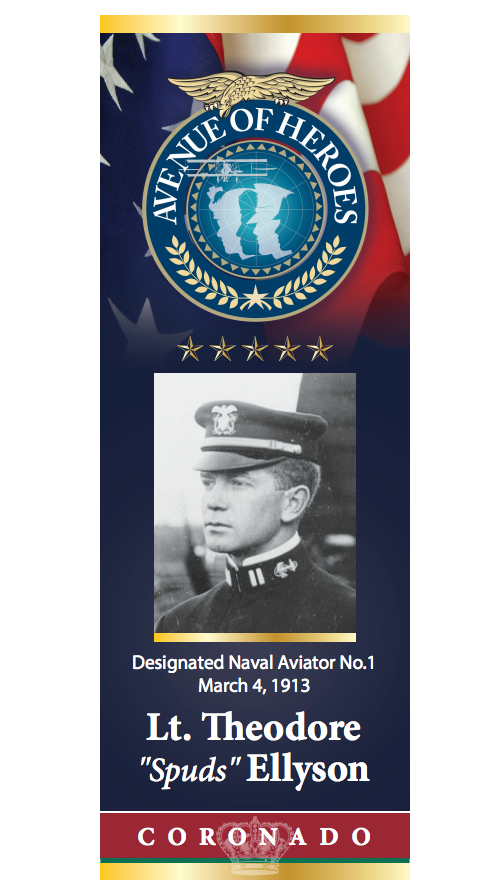
The birth of their strapping red-haired son, Theodore Gordon Ellyson, on February 27, 1885, was a proud day for Virginians, Henry and Lizzie Ellyson. No one was prepared when his life was tragically cut short exactly 43-years later.
By all accounts, Commander Theodore Gordon “Spuds” Ellyson was in a rush to be first at everythingas if he sensed his days would be short. While his time in Coronado was brief, his daring anchored North Island’s role as a leader in naval aviation and flight technology, and earned him a place in Coronado’s history – as an adopted son.
While stationed at North Island, Lt. Ellyson achieved many of the firsts he desired. He was the first naval officer assigned to aviation duty, the first passenger of a seaplane, the first pilot to land at night on water, and was first and only commander of North Island’s Camp Trouble. He was first to advocate for gear for airmen that included a “light helmet, so the engine could be heard, a leather jacket, goggles, and a life preserver.” He also prepared the first check-off list for inspecting an airplane prior to flight. His proudest first’ however, was as United States Naval Aviator No. 1.
As a brawny 14 year-old, the freckle-faced youth saw naval ships entering the bay in Hampton Rhodes and knew precisely what he wanted to do, go to sea. He even hopped a train on his own for the Naval Academy at Annapolis. Before being retrieved by his worried parents, a curious official asked him why he wanted to become a naval officer. Young Theodore replied without hesitation, “I saw the fleet come in.” His dream was realized when he attended the Academy five years later; Class of 1905.
Following graduation, Ellyson served at sea aboard (USS’) Texas, Missouri, Pennsylvania, Colorado, West Virginia, Rainbow, and USS Shark at the Asiatic Station. After his return to the states he commanded USS Tarantula and the submarine – USS Seal. He worked his way up to Lieutenant.
An urging by his friend and fellow submarine service officer, Ken Whiting, changed the course of his career. The two submitted requests to the Secretary of the Navy to learn to fly. Coincidentally, aviation innovator Glenn Curtiss, the eventual “Father of Naval Aviation,” also sent a letter to the Secretary. He offered to train a naval officer at no charge “in the construction and operation of airplanes” at his newly established flight school on Coronado’s North Island.
 In a rush to leave for the winter holiday, the Secretary reportedly grabbed the first application on his desk and on January 17, 1911, Ellyson reported for duty at North Island. This marked the birth of United States Naval Aviation.
In a rush to leave for the winter holiday, the Secretary reportedly grabbed the first application on his desk and on January 17, 1911, Ellyson reported for duty at North Island. This marked the birth of United States Naval Aviation.
Whiting, while not selected, went on to have his own distinguished career as “Father of the Aircraft Carrier.”
Glenn Curtiss had a competitive spirit, especially when it came to the Wright Brothers – who were building planes and training Army pilots in the east, so he and Ellyson were a good fit. Their relationship shored-up Curtiss’ vision of launching airplanes from ships, the development of the seaplane, and providing his airplanes to the navy.
By January 1912, Ellyson was commanding the aptly named and accident prone “Camp Trouble,” located across from the Broadway Pier in San Diego. It closed permanently in May of that year and Ellyson left Coronado.
He was assigned as head of the Aviation School at Annapolis, where he was nearly killed in an experimental launch of a seaplane from the air-compressed catapult system. A second launch attempt was scheduled after his recovery, five months later.
It was during the short break in flying that he met his “lucky charm” Helen Glenn, a daughter of prominent Atlanta politicians. Ellyson knew instantly she was the one,’ but she would only marry him if he gave up flying for one-year. He agreed, but only after the upcoming catapult launch. This time it was a success, and so was the marriage.
For unknown reasons, possibly related to a head injury, his love of flying took a “dark turn.” “I have decided to quit flying for good never to get in a machine again for any reason,” he wrote to his wife.
Escalation of world tensions took him back to sea and revived him as evidenced in a letter home, “I am really feeling fit and in good condition for the first time since I bumped my head out at San Diego.” In July of 1918, Ellyson was promoted to Commander. He was also assigned to the commission charged with carrying out the Australian Peace Treaty that ended World War 1. A role he argued he was not qualified for.
Ellyson remained in Europe until his career took a hit while Commanding USS Brooks, in what came to be known as the “Clash at Keil.” A German officer ordered Brooks out of the harbor because he believed “they were still at war with the U.S.” Commander Ellyson fiercely refused to leave. The New York Times reported, “Commander Ordered Home as Result of Clash, Admits Refusal to Leave Harbor.” In defense of his actions a robust Ellyson argued, “I didn’t tell him to go to h—, as much as had been reported.” He was relieved of command.
This took him back to Hampton Roads to serve as Executive Officer of the Naval Air Station, Naval Operating Base, and head of the Plans Division for the Bureau of Aeronautics. In 1922, Ellyson assisted in the reorganization of the Brazilian Navy. He and his family spent three years in Rio de Janeiro, where he provided technical and flight instruction.
When the family returned to the U.S., he was back at sea, first in command of Torpedo Squadron-1, then Executive Officer of USS Wright, a seaplane tender.
In what seemed as full circle in his career, Ellyson became Executive Officer of USS Lexington, the Navy’s second aircraft carrier when tragedy struck. It was his 43rd birthday when the carrier received a panicked dispatch from Annapolis that his 11-year old daughter was severely ill. The worried father was given leave and he, and Lt. Commander Hugo Schmidt, and Lt. Roger Ransehousen, took off for the two-hour flight.
The three men never made it. For over a month, Army, Navy, and Marine aviators searched Chesapeake Bay for the missing plane. Sadly, two-months later, Ellyson’s body washed ashore. He was buried at the United States Naval Academy Cemetery.
His daughter survived her illness.
Commander Ellyson continued to be honored after his death. In 1941, the destroyer USS Ellyson was named in tribute. In 1961, he was designated the recipient of the Gray Eagle Award for the period 1911 to 1928, while senior active Naval Aviator. He and Glenn Curtiss were honored in San Diego, at the El Cordova Hotel, where Helen accepted the plaque in his honor.” In 1964, Theodore “Spuds” Ellyson was enshrined in the National Aviation Hall of Fame.
The origin of Ellyson’s nickname, Spuds, remains a mystery. Whether it was his call sign, Academy moniker, or childhood pet-name is not known. Interestingly, the term “spuds” came to identify carrier aviators who’s airplane hit or came close to a ramp strike near a ship’s spud’ locker – below the rear level of the flight deck.
Next week’s Avenue of Heroes biography will be Rear Admiral Jay Prout, (Banner at Fourth and J)




